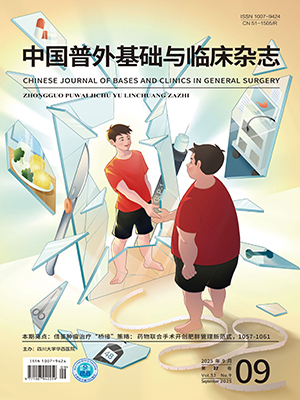Objective To explore the expressions of caudal-related homeodomain transcription factor-2 (CDX-2)
and tumor suppressor gene KAI-1 in colon carcinoma tissues and to analyze their clinical significances.
Methods Immu-nohistochemical SP method was used to detect the expressions of CDX-2 and KAI-1 in 50 cases of colon carcinoma tissues and corresponding adjacent tissues (from cancer tissue ≤2cm) and 25 cases of normal colon mucosa tissues. The relation-ships of the expressions of CDX-2 and KAI-1 to the clinicopathologic features were analyzed.
Results ①The positive rates of CDX-2 expression and KAI-1 expression in the colon carcinoma tissues were significantly lower than those in the normal colon mucosa tissues 〔CDX-2:34% (17/50) versus 88% (22/25), P<0.05;KAI-1:30% (15/50) versus 92% (23/25), P<0.05〕 and adjacent tissues of colon carcinoma 〔CDX-2:34% (17/50) versus 54% (27/50), P<0.05;KAI-1:30% (15/50) versus 58% (29/50), P<0.05〕, which in the adjacent tissues of colon carcinoma were significantly lower than those in the normal colon mucosa tissues (P<0.05). ②The positive expressions of CDX-2 and KAI-1 were related to lymph node metastasis, depth of invasion, and degree of tumor differentiation (P<0.05). ③Spearman rank correl-ation analysis showed that the CDX-2 expression was positively correlated with KAI-1 expression (rs=0.544, P<0.01).
Conclusions CDX-2 and KAI-1 may be closely related to the development, invasion, metastasis, and prognosis of colon carcinoma, the combination of CDX-2 and KAI-1 in evaluation of their function has a certain guiding significance in the treatment for colon carcinoma.
Citation: LIU Jipan,YIN Changheng,SONG Mo,YAN Qinghui. Expressions of CDX-2 and Tumor Suppressor Gene KAI-1 in Colon Carcinoma Tissues and Their Clinical Significances. CHINESE JOURNAL OF BASES AND CLINICS IN GENERAL SURGERY, 2013, 20(11): 1263-1267. doi: Copy
Copyright © the editorial department of CHINESE JOURNAL OF BASES AND CLINICS IN GENERAL SURGERY of West China Medical Publisher. All rights reserved




